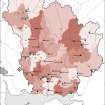Following the launch of trove.scot in February 2025 we are now planning the retiral of some of our webservices. Canmore will be switched off on 24th June 2025. Information about the closure can be found on the HES website: Retiral of HES web services | Historic Environment Scotland
Boreland, Hutton And Corrie Parish Church And Churchyard
Burial Ground (Medieval) - (20th Century), Church (18th Century) - (21st Century), Church (Medieval) - (18th Century)
Site Name Boreland, Hutton And Corrie Parish Church And Churchyard
Classification Burial Ground (Medieval) - (20th Century), Church (18th Century) - (21st Century), Church (Medieval) - (18th Century)
Alternative Name(s) Hutton On Dryfe; Hutton Magna
Canmore ID 70089
Site Number NY19SE 40
NGR NY 17048 90833
NGR Description NY 17048 90833
Datum OSGB36 - NGR
Permalink http://canmore.org.uk/site/70089
- Council Dumfries And Galloway
- Parish Hutton And Corrie
- Former Region Dumfries And Galloway
- Former District Annandale And Eskdale
- Former County Dumfries-shire
NY19SE 40.00 17048 90833
Church [NAT]
OS 1:10,000 map, 1982.
NY19SE 40.01 NY c. 1706 9084 War Memorial
NY19SE 40.02 NY 17078 90867 Churchgate Cottage
For (predecessor) Corrie Church (Corrie, Old Parish Church and Burial-ground: NY 1974 8426), see NY18SE 6.00.
For (associated) Hutton and Corrie Parish Manse (NY 17163 90655), see NY19SE 23.
Hutton (or Hutton on Dryfe) was a chapel of Sibbaldbie until 1193. The parishes of Hutton and Corrie were united in 1609.
H Scott 1915-61.
Hutton Church was built in 1710. An aisle was added in 1764.
G Hay 1957.
Hutton Magna (Glasgow, Annandale). In origin a chapel of Sibbaldbie, frequent disputes took place between the chapel and its mother church, a mutual agreement finally being reached between 1180 and 1192. Before 1193, however, Adam, lord of Hutton, with consent of Joceline, bishop of Glasgow, had granted the chapel to Jedburgh on condition that the church should become parochial and that the canons should not enter into full rights until another presentation had been made to the benefice. In a controversy between Jedburgh and the bishop of Glasgow in 1220 over vicarages, the church was ceded to the bishop. He in turn was to erect it into a prebend of his cathedral, after the decease of the then parson, from whom it apperas the abbey had received certian revenues, a full appropriation not having taken place. The prebend was not erected, however, and in 1258 the bishop granted the church to the common uses of the canons of his cathedral. However, even this proved abortive and the parsonage continued to be independent, but within the patronage of the bishops of Glasgow.
I B Cowan 1967.
(Name cited as Hutton and Corrie Parish Church). Harled kirk of 1710, the N 'aisle' added in 1764. Basket-arched windows with projecting imposts and keystones, perhaps all dating from 1799-1800, when new windows were inserted in the N wall. The two plain S windows flanking the pulpit may belong to the alterations of 1871 when Alexander Crombie added the E and N porches. Small W vestry of 1858. On the 'aisle', a red sandstone bellcote with an obelisk finial, presumably erected to satisfy the Presbytery's order of 1820 that a bellcote ne provided.
Propped against the church's S wall, two graveslabs dated 1681 and 1682, each decorated with a skull and cross bones. Just to their S, the aedicular headstone of Peter (?) Graham (died 1755), its weathered front carved with the figure of a man, a skeleton and a crown; in the open pediment, an angel's head (the soul).
J Gifford 1996.
Hutton and Corrie Parish Church [NAT]
OS (GIS) MasterMap, April 2010.
Field Visit (28 September 1993)
NY19SE 40.00 1704 9083
This T-plan church occupies a terrace towards the head of an N-facing slope. Although it bears the date 1763 over the N door, the rendering possibly hides the fabric of an earlier building, in particular its N aisle, and the datestone may relate to the remodelling of this structure. The main body of the church measures 20m by 6.5m overall.
A number of 18th-century gravestones are to be found on both sides of the church with the principal focus lying on the N, the earliest of them dating from 1729. Set upright at the W end of the S wall, within the enclosure of the Grahams of Dunanbie, there are two 17th-century graveslabs, one commemorating John Graham of Shaw (died 1681 and the other, William Graham of Shaw (died 1682). To the S of the enclosure, there is a gravestone commemorating Peter Graham in Barnsdel 'who departed this life Oct 21 1753 aged 12 years'. On the front is a figure of a man dressed in a long-skirted coat with deep cuffs, standing on a coffin, holding in his right hand a crown and in his left a sceptre. On his left a skeleton stands on a skull grasping a spear in its left hand. Above the man's head (which is notable for the large ears) there is an hour glass, and at the apex of the stone, a winged soul.
Within the church, in the wall of the N aisle, there is a mural monument commemorating the Reverend George Young (died 1749) which was erected by his son in 1757. In the N porch, there is a framed notice of 1898 setting out the heritors' regulations for the use of the burial-ground at Hutton and Corrie old churchyard (NY18SE 6.01).
Visited by RCAHMS (IMS), 28 September 1993.
Listed as Hutton, church and burial-ground.
RCAHMS 1997.


















